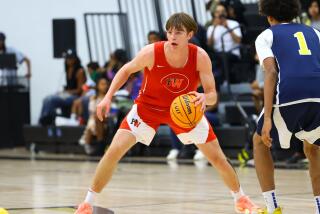Not Afraid of Heights : Major Additions Help Turn Torrey Pines Add Up to One of Countyâs Best Teams
SAN DIEGO â John Farrell could rest easy. It was mid-July, and plans for his 1987-88 basketball team at Torrey Pines High School were set.
Courtie Miller (6-feet 7-inches) and Kevin Flanagan (6-9) would only be juniors, but they were two experienced players with good size.
With the addition of 6-6 sophomore Chris Stevens, Farrell would have one of the biggest teams in the North County.
Then Neal Pollard and Jeff Fleig arrived, and Farrellâs plans changed considerably.
Pollard is a 7-foot senior center who transferred from Orem, Utah, in July. Fleig, a 6-7 senior from Reno, appeared the first day of school. Suddenly, the incumbent big guys at Torrey Pines didnât seem so big.
Farrell wasnât turning cartwheels just yet.
âIâve been coaching a long time, and there are times when you have transfers come in and it doesnât work out,â Farrell said.
But Torrey Pines, reshaped with Pollard and Fleig, has started with an 11-0 record. This was supposed to be a team that would fastbreak with three guards and two post players.
âWe had to readjust to the talent we have now,â Farrell said. âThatâs high school. Some years youâre going to have people, and some years youâre not. For size, you just have to adapt to what you have.â
The other players said they have welcomed changes they have undergone to deal with a 7-footer. Only starting point guard Tom Underwood, 5-10, is playing the same role.
- Miller expected to be one of the big players on the front line, but with Pollard and Fleig, he has been moved to guard.
âThat has been good for him,â Farrell said. âIt will make him a more desirable prospect as a senior. But thatâs not why we did it. We did it for the good of the team.â
Said Miller: âWhen Coach Farrell moved me out to wing, I had a lot more freedom. It has become a lot easier for me to move around on the floor, because the defense has to worry about Kevin and Neal.â
- Flanagan was supposed to be the teamâs center this season. But when Pollard arrived, Farrell moved the 6-9 junior to a post position.
âThat moved me out quite a bit,â Flanagan said. âFrom my point of view, thatâs great for my position, because in college, thatâs the position I will have to play.â
Fleig had always been the tallest player on every team he had played for. That meant that the only position he had been asked to play was center.
That changed.
âI always wanted to be a forward,â said Fleig, who scored 1,500 out of a possible 1,600 on his Scholastic Aptitude Test. âNow, Iâm just one of the guys on the court . . . one of the small guys, really.â
Even Pollard was forced to make some changes. He, too, had always been the central figure on his team. Offense and defense were developed to suit his needs.
At Torrey Pines, he had to become involved in a faster-paced game.
âThey have all that quickness here, they can just leave me in the dust,â Pollard said. âThe whole team was fast, so I didnât have much of a choice but to become faster.â
Pollard also has the luxury of not being double-teamed as much.
âItâs nice having guys who are almost as big as me,â he said. âEvery time a team tries to double-team me, I know I can pass to Kevin (Flanagan), and he will take it at them. Or I can pass out to Courtie or give it to the (other) guards.â
Most high school coaches are content building a program around one or two players taller than 6-4. Imagine being an opposing coach preparing for Torrey Pinesâ towering front line.
âInitially, the shock of playing against much bigger players than you are used to playing against is something you have to overcome,â said Ray Johnson, El Caminoâs coach. âItâs hard to deal with their two big kids, plus Courtie Miller because he is so mobile.
âHe can play inside or outside. If you pay a whole lot of attention to him, you leave the big guys open inside.â
Johnsonâs team lost to Torrey Pines, 79-76, in the final of the Lt. Mitchell tournament last Wednesday. Farrell called the Mitchell tournament a major test. It was the first time Torrey Pines has played in a pressure situation similar to the playoffs.
Size is fine, but Farrell is most concerned with whether this group can play as a team.
âIt took a while for us to adjust as a team,â Stevens said. âWhen Neal and Jeff came we really werenât playing as a team. Now we finally are beginning to play together.â
Farrell said Pollardâs determination to fit in was evident at a camp the team attended last August in Arizona.
âNeal and I knew we had work to do,â Farrell said. âWe knew we had to get him assimilated with everyone else on the team. By the middle of the week, he showed a lot of improvement, so we knew we were going to have a diamond in the rough.â
This is the first year either Pollard or Fleig have played varsity basketball. Both missed the bulk of their sophomore seasons with injuries. Pollard had torn ligaments in his left ankle and Fleig was out with a sprained knee. Because of the missed time, both remained on the junior varsity the next year.
Pollard said he was quickly accepted by his new teammates.
âThey all looked up the first day I walked into the gym,â he said. âEveryoneâs enthusiastic when a 7-footer walks in. They were really cool about it, they just kind of took me in.â
Now Pollard refers to the team as a family. In fact, it is similar to Pollardâs family, only shorter.
Pollardâs father, Pearl, is 6-8, and played for the University of Utah in the late 1950s. His mother, Marilyn, is 6-2. There are six kids in the Pollard family, and the only one shorter than 6-feet is the youngest, Scott, 12, who is 5-9.
Pollardâs brother Mark (6-11) is a freshman on the San Diego State team, and his brother Alan (6-9) plays at USC. Another brother, Carl (7-2), played at USC last season.
Several schools have shown an interest in Pollard, which seems almost amazing considering his days in junior high school, when his coach called him Lurp.
The nickname was coined to poke fun at Pollardâs uncoordinated play when he was about 6-2.
âEveryone thought it was funny until they had to do pushups when they laughed at me,â Pollard said. âI was real raw back then. I could barely dribble and pass, and that was about it. Usually I would just get the ball and shoot it, and then I would have a tough time putting it in.
âI survived mainly because of my size.â
By now, Pollard has grown into his 7-foot frame, and he has become much more coordinated. No longer does he get by just by with size alone. His teammates wonât let him.
âI have to keep working all the time,â Pollard said. âI canât sit back and wait for the ball, because if Iâm not open someone else will be. So I canât get the attitude that I can ever take it easy out there.â
More to Read
Get our high school sports newsletter
Prep Rally is devoted to the SoCal high school sports experience, bringing you scores, stories and a behind-the-scenes look at what makes prep sports so popular.
You may occasionally receive promotional content from the Los Angeles Times.






